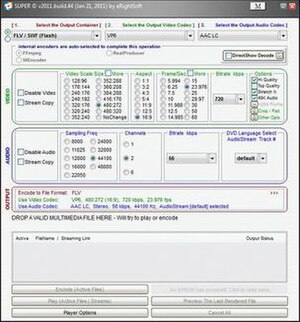SUPER (computer programme)
Topic: Software
 From HandWiki - Reading time: 3 min
From HandWiki - Reading time: 3 min
 | |
| Developer(s) | eRightSoft |
|---|---|
| Stable release | SUPER © v2019.Build.76+3D+Recorder (August 06 2019)
/ August 6, 2019 |
| Preview release | None
|
| Operating system | Microsoft Windows |
| Platform | x86 |
| Available in | English |
| Type | Transcoding |
| License | Advertisement supported freeware[1] |
| Website | www |
SUPER © [sic] (Simplified Universal Player Encoder & Recorder) with first release on 2005 is a closed-source adware front-end for open-source software video players and encoders provided by the FFmpeg, MEncoder, MPlayer, x264, ffmpeg2theora, musepack, Monkey's Audio, True Audio, WavPack, libavcodec, and the Theora/Vorbis RealProducer plugIn projects. SUPER © provides a graphical user interface to these back-end programs, which are command-line based.
eRightSoft official website states that SUPER © is available in two versions:
- SUPER © Freeware version
- SUPER © Special Edition (Totally Ads Free with exclusive extended features)
Features
SUPER can manipulate and produce many multimedia file formats supported by its back-end programs.
As of 2016, SUPER has a built-in enhanced 3D Video Converter & Recorder engine.
The proposed 3D variations are 3D Anaglyph, Polarized or Shutter side-by-side.
v2017.Build.71+3D+Recorder (April 7, 2017) offers the following encoding modes:
- Normal 2D
- 2D >> 3D
- 3D >> 2D
- 3D >> 3D
Back-end program features supported by SUPER © include saving various streaming protocols (mms, rtsp, and http), conversion of Flash Video to other formats, and user-controlled conversion of video between different container formats. Users can choose between various lossless direct audio/video transfers between container formats or lossy video/audio encoding, with encoding possessing the added ability to change video and audio specifications such as bitrate, frame rate, audio channels, resolution, sampling rate, and aspect ratio. SUPER © is also able to utilize its back-end's built-in media players, allowing playback of supported video and audio formats.
Input file format support
File formats supported by SUPER © as input source file for playing and transcoding include:
Video
- 3GP
- ASF
- AVI
- DAT
- Microsoft Digital Video Recording (DVR-MS)
- FLIC animation (FLI and FLC)
- GXF General Exchange Format
- Flash Video (FLV)
- MPEG (both MPEG-1 and MPEG-2)
- Matroska (MKV)
- MPEG-4 Part 14 container (MP4)
- MPEG transport stream (TS and M2T and TRP)
- OGM Theora/Vorbis
- Old PlayStation (STR)
- QuickTime movie (MOV and QT)
- RealVideo (RM and RMVB)
- Shockwave Flash (SWF)
- TiVo (TMF and TY and TY+)
- VivoActive (VIV)
- DVD video files (VOB)
- WebM
- WTV
- Windows Media Video (WMV)
Audio
- aac
- AC3
- ALAC
- AMR
- FLAC
- MP2
- MP3
- M4A
- Monkey's Audio Lossless (APE)
- Musepack audio SV7 & SV8(MPC)
- Ogg Vorbis
- RealAudio (RA)
- True Audio Lossless (TTA)
- SMAF cell phone audio (MMF)
- WMA
- WavPack Audio Lossless (WV)
- WAV
Other
- Avisynth scripts (AVS)
- Animated GIF images
System requirements
- Operating System: Windows XP, Windows 2003, Windows Vista, Windows 7, Windows 7 or Windows 10.
- Administrator privileges (if installed on Administrative account then subsequently converted to a Limited account during the same session, the program will work on the limited)
- Processor: Minimum 1.8 GHz Intel Pentium 4 processor or equivalent.
- 512MB of RAM with 176MB available.
- 20GB of free space on the Hard disk where the OS is installed
- 1024 × 768 video resolution or larger
- 32,000-color video or more
- IE 7 or later
- Internet connection
SUPER © is capable of working on machines with lesser capabilities; the actual minimum system requirements depend fully on the back-end programs and settings chosen by the program user.
See also
References
- ↑ "SUPER 2011 Build 49". Softpedia. SoftNews SRL. http://www.softpedia.com/get/Multimedia/Video/Encoders-Converter-DIVX-Related/SUPER.shtml. Retrieved 29 November 2011. "Users are advised to pay attention while installing this ad-supported application: Offers to download or install software or components (RealPlayer, Registry Reviver) that the program does not require to fully function."
Further reading
- Fernando Cassia (31 July 2006), Don't buy any video converter before trying this freebie, The Inquirer
- (in German) Benjamin Blaume (28 June 2008), SUPER: Der kostenlose Alles-Konvertierer, Chip.de
- Doug Sahlin, Chris Botello, YouTube for Dummies, For Dummies, 2007, ISBN:0-470-14925-6, pp. 183–184
- Rick Broida, How to Do Everything with Your Zune, McGraw-Hill Professional, 2007, ISBN:0-07-149070-1, pp. 183–185
- (in German) Ulrich Bruegmann, Divx R.t.f.m. - Divx 6, Lulu.com, 2006, ISBN:1-84728-676-3, pp. 273–274
- Sutlej Soin, The Screening Room, Singapore Hardware Mag, May 2008, p. 95
External links
 KSF
KSF